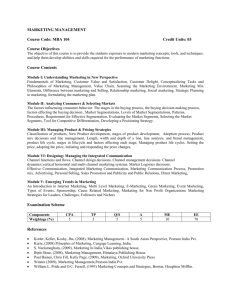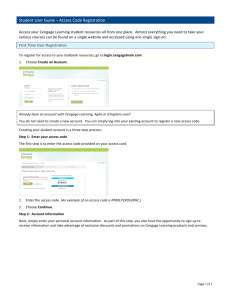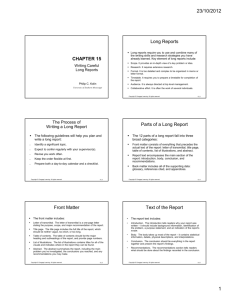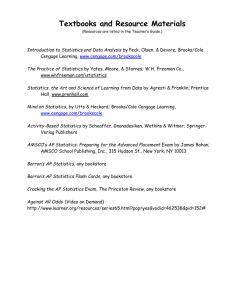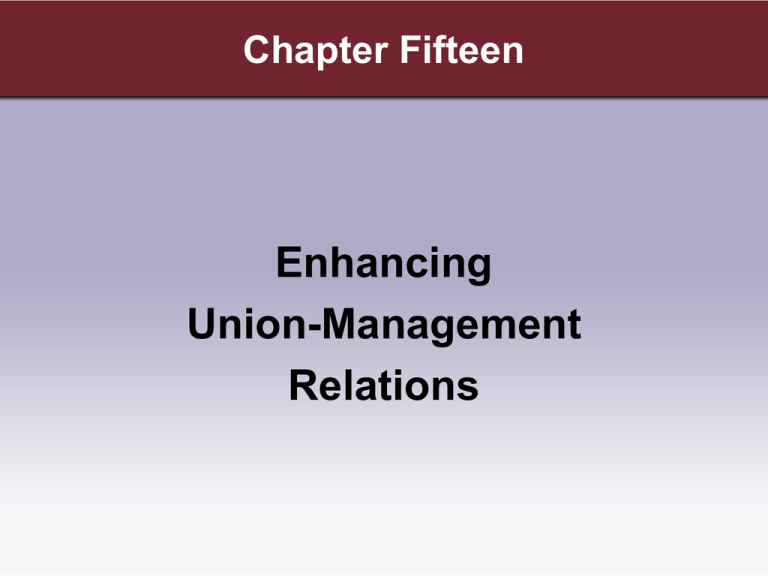
Chapter Fifteen
Enhancing
Union-Management
Relations
Learning Objectives
1. Explain how and why labor unions came into
being.
2. Discuss the sources of unions’ negotiating
power and trends in union membership.
3. Identify the main focus of several major
pieces of labor-management legislation.
4. Enumerate the steps involved in forming a
union and show how the National Labor
Relations Board is involved in the process.
Copyright © Cengage Learning. All rights reserved.
11 | 2
Learning Objectives (cont’d)
5. Describe the basic elements in the
collective-bargaining process.
6. Identify the major issues covered in a unionmanagement contract.
7. Explain the primary bargaining tools
available to unions and management.
Copyright © Cengage Learning. All rights reserved.
11 | 3
Chapter 15 Outline
– The Historical Development of Unions
• Early History
• Evolution of Contemporary Labor Organizations
– Organized Labor Today
• Union Membership
• Membership Trends
• Union-Management Partnerships
– Labor-Management Legislation
•
•
•
•
•
Norris-LaGuardia Act
National Labor Relations Act
Fair Labor Standards Act
Labor-Management Relations Act
Landrum-Griffin Act
Copyright © Cengage Learning. All rights reserved.
11 | 4
Chapter 15 Outline (cont’d)
– The Unionization Process
• Why Some Employees Join Unions
• Steps in Forming a Union
• The Role of the NLRB
– Collective Bargaining
• The First Contract
• Later Contracts
– Union-Management Contract Issues
•
•
•
•
•
Employee Pay
Working Hours
Security
Management Rights
Grievance Procedures
Copyright © Cengage Learning. All rights reserved.
11 | 5
Chapter 11 Outline (cont’d)
– Union and Management Negotiating Tools
•
•
•
•
Strikes
Slowdowns and Boycotts
Lockouts and Strikebreakers
Mediation and Arbitration
Copyright © Cengage Learning. All rights reserved.
11 | 6
Union-Management Relations
• Labor union
– An organization of workers acting together to
negotiate their wages and working conditions
with employers
• Union-management (labor) relations
– The dealings between labor union and
business management, both in the bargaining
process and beyond it
Copyright © Cengage Learning. All rights reserved.
11 | 7
The Historical Development of Unions
• Early history
– Craft union
– Knights of Labor
Copyright © Cengage Learning. All rights reserved.
11 | 8
The Historical Development of Unions
(cont’d)
• Early history (cont’d)
– American Federation of Labor (AFL)
– Industrial Workers of the World (IWW)
Copyright © Cengage Learning. All rights reserved.
11 | 9
The Historical Development of Unions
(cont’d)
• Evolution of contemporary labor
organizations
– Industrial union
– Congress of Industrial Organizations (CIO)
– AFL-CIO
Copyright © Cengage Learning. All rights reserved.
11 | 10
Organized Labor Today
• Union membership
– Approx. 15.5% of the nation’s workers belong
to unions
– AFL-CIO
– Teamsters
– United Auto Workers (UAW)
Copyright © Cengage Learning. All rights reserved.
11 | 11
Organized Labor Today (cont’d)
• Membership trends
– Union membership has declined steadily since 1980
– Heavily unionized industries have been decreasing or not
growing as fast as nonunionized industries
– Firms have moved from unionized areas (Northeast, Great
Lakes region) to less unionized areas (Southeast,
Southwest)
– Largest employment growth is in service industries, which
are typically not unionized
– Some companies are moving manufacturing to other (less
unionized) countries
– Management is providing benefits that reduce employees’
need for unionization
Copyright © Cengage Learning. All rights reserved.
11 | 12
Organized Labor Today (cont’d)
• Union-management partnerships
– The adversarial nature of past union-management
relations has given way to limited cooperative
partnerships between unions and companies
• Companies gain increased productivity,
improved quality, and reduced costs
• Workers gain increased response to their needs,
more decision-making opportunities, less
supervision, more responsibility, and increased job
security
• Unions gain credibility, strength, and increased
membership
Copyright © Cengage Learning. All rights reserved.
11 | 13
Labor-Management Legislation
•
•
•
•
Norris-LaGuardia Act (1932)
National Labor Relations Act / Wagner Act (1935)
Fair Labor Standards Act (1938)
Labor-Management Relations Act / Taft-Hartley Act
(1947)
• Landrum-Griffin Act (1959)
Copyright © Cengage Learning. All rights reserved.
11 | 14
The Unionization Process
• Why some employees join unions
– As a way to combat alienation and loss of personal
identity from dull and repetitive jobs
– Due to the perception that union membership
increases job security
– As a way of expressing dissatisfaction with one or
more elements of the job
– Due to personal background (family history of union
membership)
– As a requirement to keep a job under provisions of
the labor contract between the union and the firm
Copyright © Cengage Learning. All rights reserved.
11 | 15
Steps in Forming a Union (cont’d)
• Complicating factors
– Bargaining unit
– Jurisdiction
Copyright © Cengage Learning. All rights reserved.
11 | 16
Steps in Forming a Union (cont’d)
• The Role of the NLRB
–
–
–
–
Overseeing organizing campaign
Conducting the election
Certifying the results
Monitoring questionable behavior
Copyright © Cengage Learning. All rights reserved.
11 | 17
Collective Bargaining
• The process of negotiating a labor contract with management
• First contract
– Pre-negotiation preparations by both parties
– Exchange of initial contract demands by union and company
– Bargaining over issues until agreement is reached (or strike)
– Agreement is ratified by a vote of the union membership
– Agreement is signed and becomes a legally binding agreement (or
more negotiation)
• Later contracts
– Pre-negotiation preparations are more intense
– Each side may take a harder line on the issues in negotiations
– Contract expiration date produces tension
Copyright © Cengage Learning. All rights reserved.
11 | 18
Union-Management Contract Issues
• Employee pay
– Forms of pay
• Direct compensation
• Deferred compensation
– Magnitude of pay
• Parity with local and national industry
pay levels
• Real wage protection through cost-of-living clauses
• Financial condition of employer
• Cost-sharing for benefits
Copyright © Cengage Learning. All rights reserved.
11 | 19
Union-Management Contract Issues
(cont’d)
• Employee pay (cont’d)
– Pay determinants
• Management seeks to tie wages to each
employee’s productivity
• Unions feel this creates unnecessary competition
and usually suggest pay according to seniority
• Management seeks to constrain benefits to only
some employees
• Unions want equal application of benefits
Copyright © Cengage Learning. All rights reserved.
11 | 20
Union-Management Contract Issues
(cont’d)
• Working hours
–
–
–
–
–
–
Overtime
Special hourly rates for weekend or holiday work
The right of employees to refuse overtime
Premium pay for workers on less desirable shifts
Starting times
Length of meal periods and work breaks
Copyright © Cengage Learning. All rights reserved.
11 | 21
Union-Management Contract Issues
(cont’d)
• Security
– For the individual
• Job security
• Seniority
– For the union
• Membership
• Closed shop
• Union shop
• Agency shop
• Maintenance shop
Copyright © Cengage Learning. All rights reserved.
11 | 22
Union-Management Contract Issues
(cont’d)
• Management rights
– The firm wants to control whom it hires, how
work is scheduled, how discipline is handled
– Unions seek to control these matters
– Some union executives have been given seats
on corporate boards of directors
Copyright © Cengage Learning. All rights reserved.
11 | 23
Union and Management
Negotiating Tools
• Strikes
– Picketing
– Wildcat strike
• Slowdowns and boycotts
– Slowdown
– Boycott
Copyright © Cengage Learning. All rights reserved.
11 | 24
Union and Management
Negotiating Tools (cont’d)
• Lockouts and strikebreakers
– Lockout
– Strikebreaker
• Mediation and arbitration
– Mediation
– Arbitration
Copyright © Cengage Learning. All rights reserved.
11 | 25

